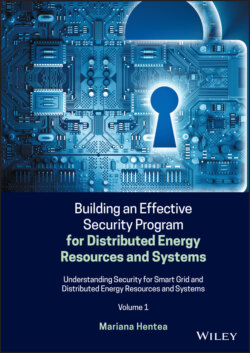Читать книгу Building an Effective Security Program for Distributed Energy Resources and Systems - Mariana Hentea - Страница 28
1.3.2 DER Uses
ОглавлениеBehind‐the‐meter DER may be bundled with regular load and managed alongside the demand response (DR) resources – such as a residential rooftop PV solar panel. But often, DER is treated separately in part due to its control capabilities. In addition to a regular retail tariff, behind‐the‐meter DER may be subject to net metering or feed‐in tariff, where excess generation can be exported to the grid at an established or a dynamic price.
Similar to DR resources, DER assets can be registered and enrolled into a DR program. DR is defined as changes in electric use by demand‐side resources from their normal consumption patterns in response to changes in the price of electricity or to incentive payments designed to induce lower electricity use at times of high wholesale market prices or when system reliability is jeopardized [FERC 2012].
Furthermore, DER assets are typically required to meet additional technical requirements and certification for grid interconnection.
Depending on the size of a DER and its export capabilities, submetering and telemetry capabilities may be required to monitor the impact of the DER operation on the distribution grid reliability and power quality. Also, renewable resources may receive renewable energy credits (RECs) and may also qualify as a must‐run resource, e.g. wind power in some regions. These capabilities need to be incorporated into pricing and control signals associated with DER operation.
Also, DER systems can be interconnected with many other systems in the Smart Grid. The major systems interconnected with DER systems are microgrids, distribution system, and synchrophasor system. These systems such as microgrid and synchrophasor system along with DER help in providing high‐quality energy with increased efficiency and reliability where consumer can produce and manage their energy usage. Distribution system helps in connecting these independent generation units with the main power grid.
As the penetration rate of renewable energy increases, besides issues on how to connect renewable to power grid and operate the renewable or how to build storage plants, other issues have to be addressed. These challenges include:
Implementation of priority applications as identified by Federal Energy Regulatory Commission (FERC) [FERC 2009]:Demand and response.Wide area situational awareness, which means to know continually what is going on in space and time in a dynamic environment, with awareness of potential threats, opportunities, and the range and implications of potential actions and options.Energy storage.Electric transportation.
A consistent approach for integrating the communication backbone for providing business and control information between different systems, entities, consumers, and service providers [EPRI 2007].
Interoperability and standard interfaces between systems as well as interfaces with DER networks and systems [EPRI 2007].
However, these additional requirements exceed the capabilities of the existing grid. They cannot be achieved by simply modifying the current supervisory control and data acquisition (SCADA) network. Therefore, the Smart Grid communication network must incorporate new design features that also accommodate other two major requirements:
Integration of time‐dependent renewable resources.
Controlling the load that is affected by the dynamic consumer demand and response.
Other examples of the new technologies and applications include:
Utility‐scale renewable sources that feed energy into the transmission system.
Distributed and renewable energy resources that feed into the distribution system.
PEVs, which will potentially create large load increases in some sections of the grid.
New demand‐side management techniques that will give consumers interactive ways to participate in Smart Grid markets.
Storage technologies that allow introducing some latency between the generation and consumption cycles to help compensate for the time‐varying nature of renewable resources such as wind or solar energy.
Also, FERC [FERC 2009] identifies two crosscutting priorities, namely, cybersecurity and communication and coordination across intersystem interfaces.
